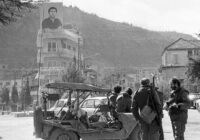History and legacy provide an explanation as to why the radical right has a stronger presence in some parts of the UK.
Anyone listening to the news coverage of the 2018 British local elections would have heard a clear narrative around the radical right — that, at least electorally, things were not going well for them. The UK Independence Party (UKIP) lost heavily, despite recent pivots toward embracing groups like the Democratic Football Lads Alliance, and it was much publicized that the British National Party (BNP) lost its final councilor, failing to even defend its last seat.
There is no sign of this trend in elections going away in Britain, with UKIP predicted by many to suffer a similar scale of loss next year. These national narratives, however, can only ever tell a small part of the story with radical-right groups, often splintered and having for most of their history enjoyed sporadic support usually focused around key areas of strength.
Northamptonshire is a sleepy East Midlands shire. It’s main town has a population of under 300,000 and has failed to be made a city, despite formerly being a favourite residence of the royal court under the Angevin kings. It is commuter belt for London, and the east of the county has diverse populations in towns like Wellingborough, with the University of Northampton showing relatively high BME (black or minority ethnic) recruitment for the shires — 40% of undergraduates in the 2016 reports.
Yet we find a strand here which bucks these national trends. Rather than seeing a declining radical right, it seems — at least locally — to be preserving its strength in many ways. In 2016, local former BNP organizer Larry Nunn tried to forge a unified front on the radical right from Northampton, and he has in recent years used Northampton as a base from which to organize training weekends for younger members of the nationalist groups. More recently in 2017, soldiers from Northampton were arrested as part of an operation to end infiltration of the armed forces by the banned group National Action, with Larry Nunn again appearing in coverage of the event in Searchlight.
In the town of Desborough, we find a UKIP town councilor — though now resigned — who stood in the 1997 General Election for the National Democrats, the renamed National Front. In the same town, just as the BNP were laughed at for losing their last councillor in the 2018 local elections, we have seen the re-emergence of a BNP candidate for that town council. Further south along the A6, in the town of Higham Ferrers, at a February by-election involving a BME candidate, we saw the involvement of White Pendragon shortly after the group’s invasion of the Fabian Society conference — thankfully, it seems, just in chatter rather than practical action.
The local UKIP branch that covers Higham Ferrers is now active in promoting links with radical groups like UKIP Christian Soldiers, including talks from climate change deniers, and is especially vocal in promoting its support of the Democratic Football Lads Alliance. The same branch garners over a thousand likes on Facebook, over 10 times the support of the ruling local Conservatives. While not a sign of electoral support, it does suggest a core of dedicated activists who will continue to maintain activity long into the electoral decline.
The answer to why there is this stubborn seam of the radical right in the area, stretching from its more acceptable side to its most intolerable, cannot simply be answered in contemporary events and politics. That understanding must be informed by the history of the area, the radical right’s past networks, and also by its geography and the links between towns. Specifically in the case of towns like Desborough and Higham Ferrers, along with towns of historic radical-right presence like Rothwell, these all reside along the A6 corridor down from Leicester, a former bastion of the National Front, the British Movement and other groups.
The violent nature of some of the radical right in Northamptonshire also has echoes in 1970s Leicester, where Peter Ash and Tony Verity took over operations following John Tyndall’s return to leadership. Verity was a former member of the more violent Honour Guard section of the Front, while Ash ran the regional printing operation that helped support activity across the East Midlands. Leicester was a stronghold for the National Front in the region, as the group’s own internal newsletters held at the Searchlight Archive reveal spending well over £1,200 ($1,600) in the 1976 elections alone — well over £8,000 ($11,000) in today’s money.
This successful operation had worked to support National Front activity by the Loughborough Group in 1972 at the Mansfield Hosiery Mills, with support of strikes across the region against migrant labor, continuing with leaflets in 1973 and most famously opposing South Asian strikers at the Imperial Typewriters in Leicester itself in 1974. Loughborough, of course, sits north of Leicester, connected once again by the A6.
We can trace, through the newsletters, the action days and activity with campaigns in Oadby and Wigston district (and Oadby straddles the A6) and Blaby district, southwest of Leicester. There are even letters in the archive where violent groups discuss use of an abseiling and wilderness skills center near Higham Ferrers for training during this period. Yet most of these campaigners are now gone. The parties they represented broken apart and fragmented.
In terms of direct influence of the National Front along the A6 corridor, rather obviously there is little. Yet that history and legacy remain an explanation for why we see today continued activity of the radical right in these areas in strength that would counter national narratives. The geography of the area and its history can help offer a possible explanation for why we see these movements in areas we don’t necessarily expect.
In the meantime, if someone says that the 2018 local elections were the end of any of the political parties of the radical right, remember that in Desborough on May 3, 4% of voters were still willing to put a cross for the British National Party.
*[The Centre for Analysis of the Radical Right is a partner institution of Fair Observer.]
The views expressed in this article are the author’s own and do not necessarily reflect Fair Observer’s editorial policy.
Photo Credit: chrisdorney / Shutterstock.com
Support Fair Observer
We rely on your support for our independence, diversity and quality.
For more than 10 years, Fair Observer has been free, fair and independent. No billionaire owns us, no advertisers control us. We are a reader-supported nonprofit. Unlike many other publications, we keep our content free for readers regardless of where they live or whether they can afford to pay. We have no paywalls and no ads.
In the post-truth era of fake news, echo chambers and filter bubbles, we publish a plurality of perspectives from around the world. Anyone can publish with us, but everyone goes through a rigorous editorial process. So, you get fact-checked, well-reasoned content instead of noise.
We publish 2,500+ voices from 90+ countries. We also conduct education and training programs
on subjects ranging from digital media and journalism to writing and critical thinking. This
doesn’t come cheap. Servers, editors, trainers and web developers cost
money.
Please consider supporting us on a regular basis as a recurring donor or a
sustaining member.
Will you support FO’s journalism?
We rely on your support for our independence, diversity and quality.






